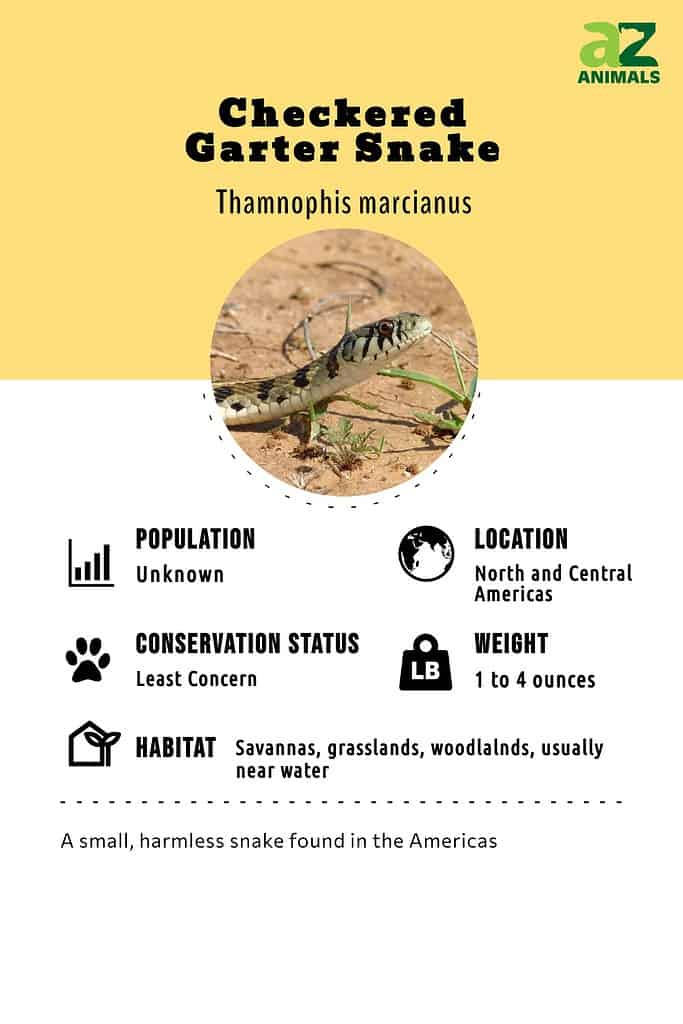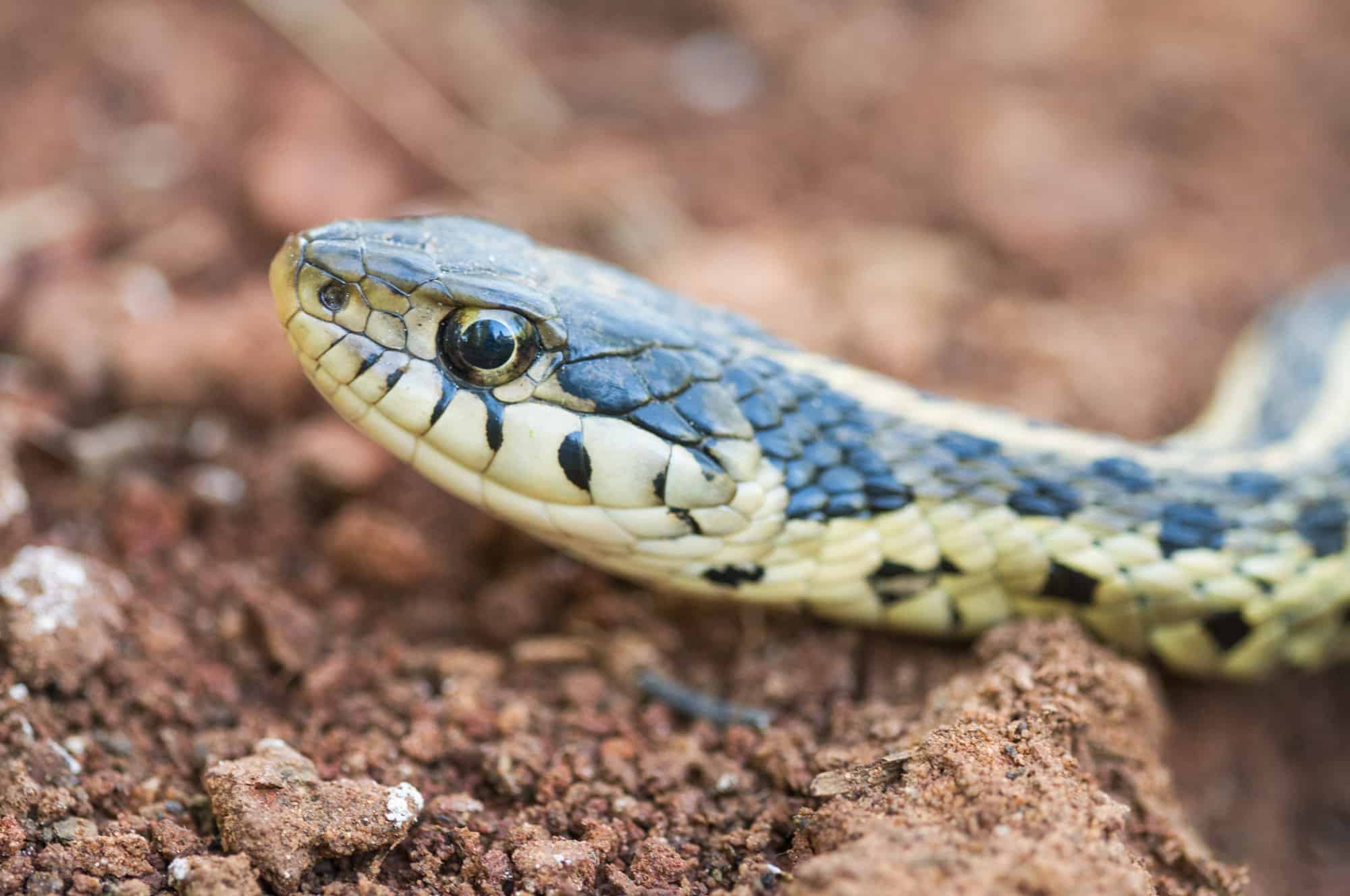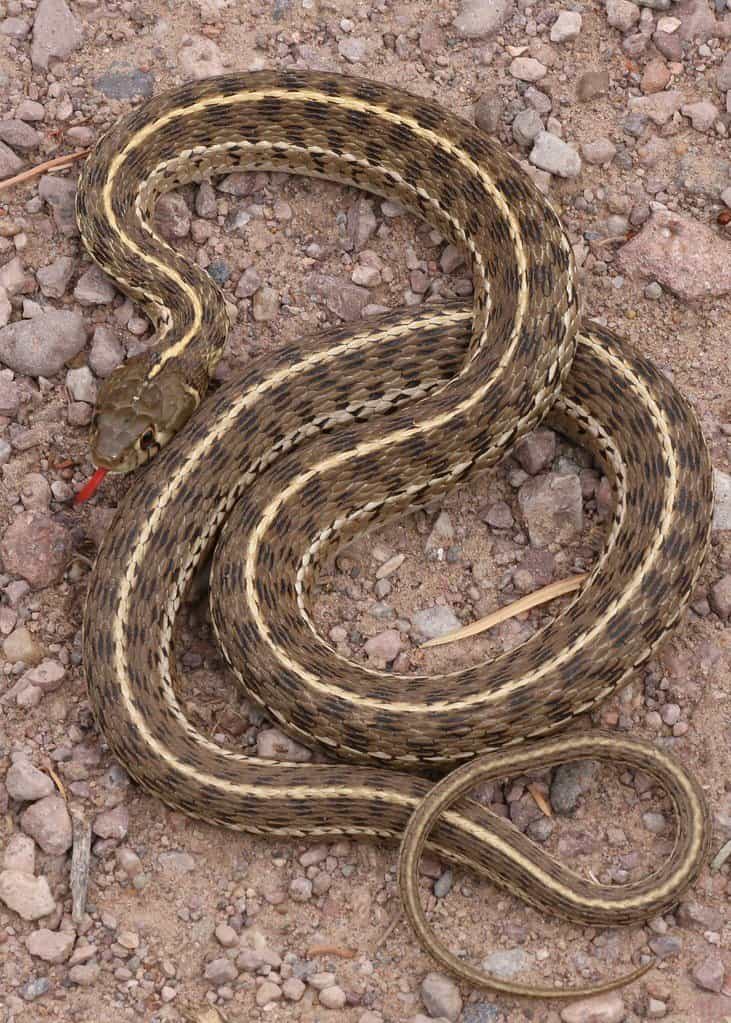Checkered Garter Snake
Thamnophis marcianus
It has the ability to expel a stinky liquid from its body as a way to make predators (and humans) retreat!
Advertisement
Checkered Garter Snake Scientific Classification
- Kingdom
- Animalia
- Phylum
- Chordata
- Class
- Reptilia
- Order
- Squamata
- Family
- Colubridae
- Genus
- Thamnophis
- Scientific Name
- Thamnophis marcianus
Read our Complete Guide to Classification of Animals.
Checkered Garter Snake Conservation Status
Checkered Garter Snake Facts
- Name Of Young
- Snakelets or neonates
- Fun Fact
- It has the ability to expel a stinky liquid from its body as a way to make predators (and humans) retreat!
- Most Distinctive Feature
- Its black and white checkered pattern
- Distinctive Feature
- Slender body with a thin tail
- Litter Size
- 6 - 35 snakelets
- Diet
- Carnivore
- Favorite Food
- Frogs, toads, small fish, worms, mice, moles, and other rodents
Checkered Garter Snake Physical Characteristics
- Skin Type
- Scales
- Venomous
- Yes
- Aggression
- Low
View all of the Checkered Garter Snake images!
Checkered garter snakes can release a stinky liquid to escape predators.
The checkered garter snake is aptly named for the black and white checkered pattern of scales running down its back. Frogs, worms, toads, and small fish are all a part of the diet of this snake. In terms of habitat, this snake can thrive in many places, including savannas, grasslands, woodlands, and deserts. It measures just 18 to 24 inches long. Its small size is just one reason why some people care for these reptiles as pets.

4 Amazing Facts
- A rare albino type of this snake has white/yellow scales and red eyes
- It gives live birth to as many as 35 snakelets
- Its venom is deadly to its prey but not to humans
- It spends winter brumation inside a burrow with several other garter snakes.
Habitat: Where to Find Them

Checkered garter snakes have round eyes with black pupils.
©James Brunner Photography/ via Getty Images
The checkered garter snake lives in North America and Central America. They are seen in the southwestern United States in Texas, New Mexico, and Arizona. Mexico is also home to this snake. Belize, Costa Rica, Guatemala, Honduras, and Nicaragua are other places to find the checkered garter snake.
Checkered garter snakes live in a temperate climate. They’re found in varied habitats, including savannahs, deserts, woodlands, and grasslands. It’s not unusual to spot these snakes near rivers, ponds, and streams.
The activity of this snake increases during mating season in the spring, specifically from late March to April. Alternatively, they disappear into rock crevices and abandoned burrows in the wintertime to brumate with other garter snakes.
Countries where the checkered garter snake lives:
Scientific Name
Thamnophis marcianus is the scientific name of the checkered garter snake. The name marcianus is a reference to General Marcy, a well-known frontier surveyor in the mid-1800s.
It belongs to the Colubridae family and class Reptilia.
The subspecies of this snake include:
• Thamnophis marcianus praeocularis
• Thamnophis marcianus bovalli
Population & Conservation Status
The population of the checkered garter snake varies depending on the region. It’s described by the IUCN Red List of Threatened Species as abundant in Texas and rare in Costa Rica. As a consequence, there’s not exact population listed for this garter snake. It’s categorized as Least Concern.
Appearance and Description

Most checkered garter snakes reach a maximum of 18 to 24 inches long.
©
The ridged scales on the back of this snake are green with a black and white checkered pattern. There is a long white stripe down the middle of its back all the way to the end of its thin tail. The middle stripe is bordered by two more narrow, white stripes. The snake has a green head with black and white vertical stripes around its mouth. It has a white belly with narrow black bars and round eyes with black pupils.
Normally, the snake is 18 to 24 inches long but can be as large as 42 inches.
How to identify a checkered garter snake:
- Green base scales with a black and white checkered pattern
- A long white stripe down the middle of its back bordered by two thinner white stripes
- A slender body with a thin tail
- A green head with black and white stripes around its mouth
- A white belly with narrow black bars
- Round pupils
An albino checkered garter snake is a rare find in nature. The albino variety of this snake has white or yellowish scales and red eyes. Otherwise, it’s the same size sharing the same diet and habits as other garter snakes. It’s albino due to a genetic abnormality.
Diet
Checkered garter snakes are carnivorous and primarily feed on small fish, frogs, toads, salamanders, insects, earthworms, and slugs. They hunt mostly in water or near bodies of water by using their sense of smell to locate prey. In addition to hunting for food in the wild, they will often scavenge for food as well. Checkered garter snakes are excellent swimmers and have been known to travel long distances over land in search of a meal. When not actively hunting, checkered garter snakes can be found basking in the sun or hiding under rocks or logs during the day. At night they become more active and may travel several miles in search of food which makes them an important predator species within aquatic ecosystems.
How Dangerous Are They?

The checkered garter snake is aptly named for the black and white checkered pattern of scales running down its back.
©iStock.com/slowmotiongli
Checkered garter snakes have venom but are not dangerous to humans. Their venom is not like the venom of a copperhead or cobra. A checkered garter snake’s venom is so mild it doesn’t pose a threat to people. Furthermore, this snake has small teeth, so its bite feels a lot like a sting.
Though the checkered garter snake is not poisonous to a human, there is some care necessary to address a bite from this reptile.
If the bite breaks through the skin, wash the area with soap and water. Next, apply first-aid cream to stave off infection. Then, cover the bite marks with a bandage to protect it as the skin heals. If a lot of redness or swelling develops around the bite wound, it needs additional care from a medical professional. Some garter snakes carry bacteria in their mouth, so it’s a good idea to get the bite checked if it doesn’t heal in a timely way.
A checkered garter snake has a secret weapon it uses against threats. It has the ability to expel a stinky liquid from its body as a way to make predators (and humans) retreat! The predator is so surprised and grossed out by the stinky liquid it lets the snake go!
Behavior and Humans

Checkered garter snakes like to live near water and bask on rocks in the sun.
©James Brunner Photography/ via Getty Images
This snake’s wide variety of habitats increases the chances of an encounter with humans. A person who lives near a field, a wooded area, or even an overgrown empty lot is more likely to see this snake than someone residing in an urban area. The checkered garter snake is timid and inclined to slither away at the first sign of a human.
The checkered garter snake is a small to medium-sized species of reptile that typically inhabits wetland areas. They are relatively active during the day, especially in warmer months, and can be seen basking in the sun or hunting for prey. They feed mainly on small amphibians such as frogs and salamanders but will also eat fish, insects, and even other snakes.
These reptiles are known to be quite territorial by nature and have been observed carrying out ‘combat’ behavior when two males cross paths. This involves pushing each other with their heads before one eventually retreats from the area. It has also been reported that they may occasionally produce loud hissing noises as part of this display of dominance as well.
When it comes to breeding season (spring-summer), checkered garter snakes form large communal mating balls where multiple male individuals compete for access to a single female mate within the group. Males use their tails to entwine around those of potential mates while using body movements such as thrashing back and forth in an attempt to court them successfully. Once successful mating has taken place, females will lay eggs shortly afterward, which hatch after about six weeks incubation period in warm conditions.
Reproduction and Life Cycle
The checkered garter snake reproduces through internal fertilization, where the male snake transfers sperm to the female during mating. The females give birth to live young in late summer or early autumn, usually with clutches of 3-20 snakes. These juvenile snakes are born around 6–8 inches long and will reach adulthood at about 16–24 inches when fully grown. Checkered garter snakes typically live for between 6 and 10 years in the wild but can survive up to 20 years if given proper care in captivity.
Similar Animals
View all 235 animals that start with CCheckered Garter Snake FAQs (Frequently Asked Questions)
Are checkered garter snakes venomous?
Yes, but their venom is different from the venom of a copperhead. A checkered garter snake’s venom is considered harmless to people whereas the venom of a copperhead can cause muscle and tissue damage in a human.
How do checkered garter snakes hunt?
Checkered garter snakes are very fast when pursuing their prey. Once they catch up to a rodent or frog, the snake gives it a bite. It moves its mouth as if it’s chewing on the prey to release its mild venom. Once the animal is dead, it’s swallowed by this snake. Depending on the size of the prey, the checkered garter snake may not need to eat every day.
Are checkered garter snakes aggressive?
No, they have a timid nature except for when they are pursuing prey!
Where do checkered garter snakes live?
These snakes live in the southwestern United States including Texas, New Mexico, and Arizona. Other places where they are found include Mexico, Belize, Costa Rica, Guatemala, Honduras, and Nicaragua.
They are found in a desert habitat, in savannahs, woodlands, and grasslands.
What do checkered garter snakes eat?
Mice, toads, frogs, worms, and small fish make up the diet of this snake.
Are checkered garter snakes poisonous to dogs?
It depends. It’s not uncommon for a dog to find a checkered garter snake slithering in a yard or around a large piece of property. If a dog gets a bite from a checkered garter snake, its venom doesn’t pose any real harm to the canine. This is especially true if the dog is large in size. But a dog who eats and swallows this snake can become sick. It should be taken to the vet.
Remember this snake can release a stinky liquid to deter predators including friendly dogs. So, there’s a good chance a dog wouldn’t want to chew on or swallow a snake that has released this liquid.
Why is the checkered garter snake endangered?
The checkered garter snake is not categorized as endangered. However, its numbers are decreasing in some regions due to habitat loss and loss of some types of prey.
How can you tell if a garter snake is a checkered garter snake?
The black and white checkered pattern on this snake is a sure way to tell if it’s a common garter snake or the checkered variety.
Where are checkered garter snakes found?
Checkered garter snakes live in rock crevices, in hollow logs or in abandoned rodent burrows. In the wintertime, they go into brumation with several other garter snakes inside a burrow or crevice. These snakes are normally solitary but gather together in one place for the winter to keep each other warm.
Thank you for reading! Have some feedback for us? Contact the AZ Animals editorial team.
Sources
- Kansas Outdoors / Accessed May 3, 2022
- IUCN Red List / Accessed May 3, 2022
- EOL / Accessed May 3, 2022
- Wikipedia / Accessed May 3, 2022
- Woof Now What / Accessed May 3, 2022
- Embora Pets / Accessed May 3, 2022


















